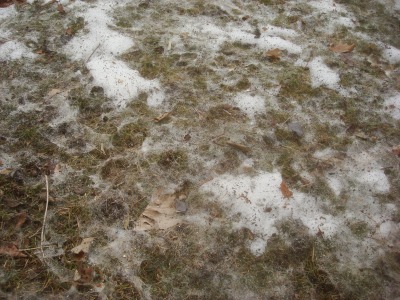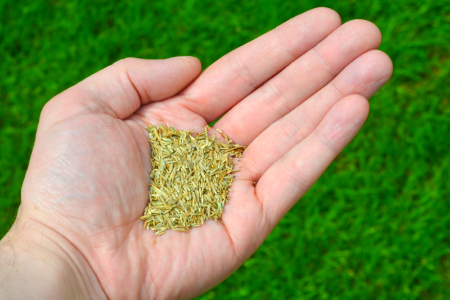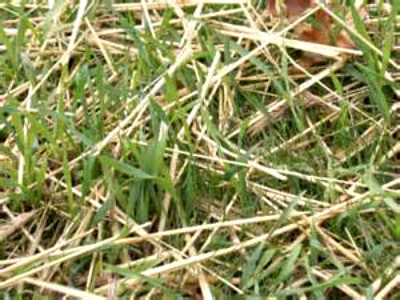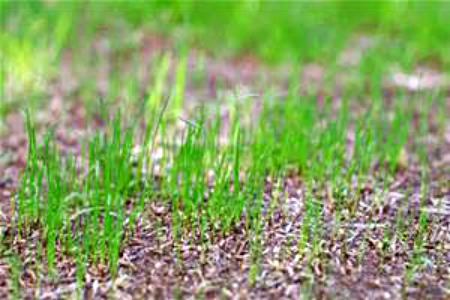How to Repair Winter Lawn Damage
Each winter all of our lawns incur some damage. If heavy snow lays in one area too long it can cause snow mold which can kill grass. Or usually we all incur some kind of “snow plow” damage, or somebody drives off the driveway leaving a muddy track in the lawn. Whatever the case, it has to be repaired for the lawn to look good again.

Snow Mold
Repairing lawn damage is easy enough to do. The secret is to get out there early and get it repaired before it gets really hot because intense sun makes it really difficult to establish new grass.
There are no secrets to planting grass seed, but there are a few tips that I’d like to share with you.
First of all, loosen up the soil by whatever means it takes. In order for grass to grow nicely you have to start with loose soil. If you put grass seed on hard packed soil as soon as it rains all the seed washes into the lowest area. If the soil is loose, the rain soaks in and kind of permanently put the seed in its place.
Buy grass seed that is a blend of several different types of grasses. Kentucky Blue Grass is great, but it takes 28 days to germinate and usually before that happens the weeds take over, the birds eat the seed, or the seed gets washed away. If you get a blend of grass seed that contains a fescue, a couple of kinds of perennial rye grass and some Kentucky Blue Grass, you’ll get quick germination from the perennial rye grass, and that acts as a nurse crop protecting the Kentucky Blue until it has a chance to germinate.
Cheap grass seed is cheap. It often contains ugly thick bladed grasses that you don’t want in your lawn. You don’t have to buy the most expensive grass seed on the market, but you should be a few notches above the cheap stuff.
New grass seed really likes a little bit of shade as it establishes itself. Straw makes a great mulch because straw sits above the soil and actually shades those little tiny seeds. But straw can be messy, and it can be hard to find. In that case you can use the green seed starter mulch. It works pretty well and contains starter fertilizer.
To plant the seed just sprinkle it over the loose soil. You should apply the grass seed at a rate of 5 to 6 pounds per 1,000 square feet. After you apply the grass seed take a broom or a leaf rake and gently drag the tool over the area you seeded. Turn the leaf rake upside down so it doesn’t dig into the soil. This covers the seed with a very light layer of soil, or at least presses the seed into the soil. Then apply your mulch or straw.
Water immediately and water on a regular basis. Allow the soil to dry slightly between watering, but just ever so slightly. In about 5 or 6 days you will start to see tiny grass plants. Make sure to not miss any watering as these tiny plants try to establish themselves. It is really, really important to keep new grass watered on a regular basis.
New grass plants are as thin as a human hair and even the shortest time without water and they will die.
Once that happens they are gone forever because the seed is spent, and the new plant has failed.
And that’s why so many people have trouble establishing new grass. They do everything right, up to the point of keeping up with the watering. They do okay for the first few days, then they forget.
That’s why it’s so much easier to plant grass now, because in the spring the watering is less critical. The grass should be watered, but while you are at work your new grass will be fine until you get home. In the middle of summer that’s not the case.
Now go plant some grass!
Take care, have a great day and by all means stay inspired!
-Mike McGroarty
Thanks for letting us in on your tips!!
Hi Mike,
I tried to kill some weeds in my grass that spread from my neighbors grass like “creeping Charlie” and other large weeds in my own grass by using a product that says it just kills weeds not grass. Now my grass has large burnt patches that seemed to have spread all over my lawn. I feel terrible about how ugly I made the lawn look. Is there anything I can do now in almost mid September to fix it? I live in MI at zone 6..
Thank you.
It’s nice to learn more about grass seed. I like the fact that you can just sprinkle it over loose soil and watch it grow. We need some more grass in certain areas, but so I’ll find someone to do this for us.
Mike, Having left a comment on another article, it is my hope that you somehow find this “reply” and can/will offer some advice. We live in the Dayton OH area as previously mentioned. Our dilemma…the fenced in area of our backyard where our two German Short Hair Pointers roam, was destroyed first by the fence installers hitting one of the supply lines for the sprinkler system, then by the pups having fun in the muddy lake left by the abundance of water that was due to the fence being installed. We may have over-corrected our situation by the use of straw in our attempts to minimize the mud being dragged into our house by our dogs. This situation has been ongoing for the past couple of years. We now have a sizable area of our yard that is star-covered compost…the extent of the compost being nearly 4 inches deep. After heavy rains, the area remains “mucky” underneath. Whether or not the compost will accept grass seed is my question…or will it be necessary to somehow remove as much of the composted material and replace with topsoil? the area used to be a beautiful lawn. About twice each year we have scattered 25 bales of straw to keep the area as dry as possible. Those decaying bales are the source of the compost. Perhaps we would be better off utilizing sod rather than seed. I honestly don’t know. Again, hoping for any suggestions, advice, whatever you may offer.
Jim,
I did see your question and replied. Not sure what article, it could be several pages deep on this article. I’d rake up some, as much as make sense, of the straw and plant the grass seed right around the 1st of April. You might want to over seed again in late April. I think it will work if you can keep the dogs off until the grass is established.